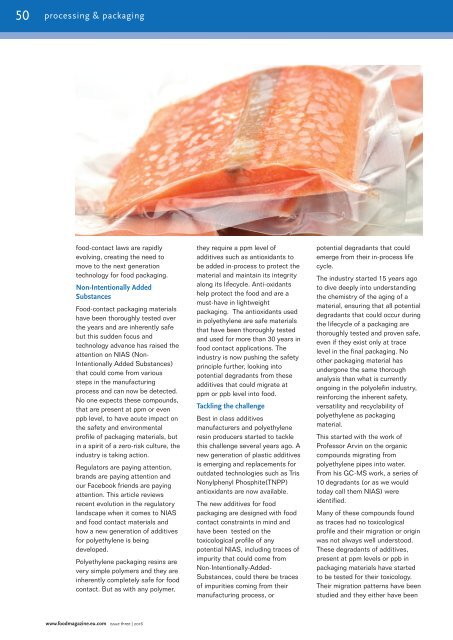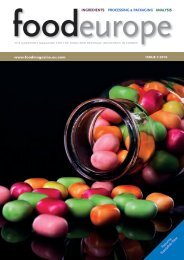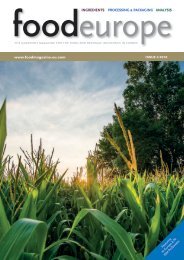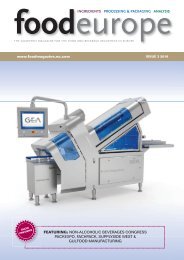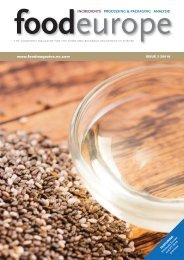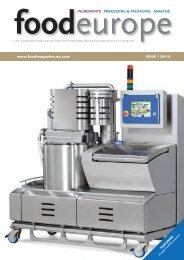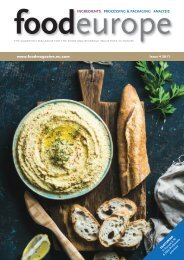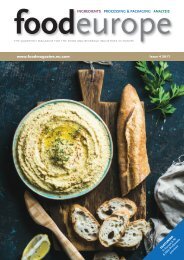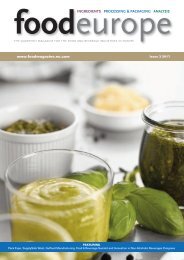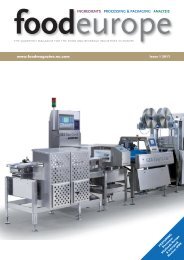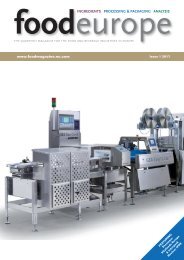Issue 3 2016
Create successful ePaper yourself
Turn your PDF publications into a flip-book with our unique Google optimized e-Paper software.
50<br />
processing & packaging<br />
food-contact laws are rapidly<br />
evolving, creating the need to<br />
move to the next generation<br />
technology for food packaging.<br />
Non-Intentionally Added<br />
Substances<br />
Food-contact packaging materials<br />
have been thoroughly tested over<br />
the years and are inherently safe<br />
but this sudden focus and<br />
technology advance has raised the<br />
attention on NIAS (Non-<br />
Intentionally Added Substances)<br />
that could come from various<br />
steps in the manufacturing<br />
process and can now be detected.<br />
No one expects these compounds,<br />
that are present at ppm or even<br />
ppb level, to have acute impact on<br />
the safety and environmental<br />
profile of packaging materials, but<br />
in a spirit of a zero-risk culture, the<br />
industry is taking action.<br />
Regulators are paying attention,<br />
brands are paying attention and<br />
our Facebook friends are paying<br />
attention. This article reviews<br />
recent evolution in the regulatory<br />
landscape when it comes to NIAS<br />
and food contact materials and<br />
how a new generation of additives<br />
for polyethylene is being<br />
developed.<br />
Polyethylene packaging resins are<br />
very simple polymers and they are<br />
inherently completely safe for food<br />
contact. But as with any polymer,<br />
they require a ppm level of<br />
additives such as antioxidants to<br />
be added in-process to protect the<br />
material and maintain its integrity<br />
along its lifecycle. Anti-oxidants<br />
help protect the food and are a<br />
must-have in lightweight<br />
packaging. The antioxidants used<br />
in polyethylene are safe materials<br />
that have been thoroughly tested<br />
and used for more than 30 years in<br />
food contact applications. The<br />
industry is now pushing the safety<br />
principle further, looking into<br />
potential degradants from these<br />
additives that could migrate at<br />
ppm or ppb level into food.<br />
Tackling the challenge<br />
Best in class additives<br />
manufacturers and polyethylene<br />
resin producers started to tackle<br />
this challenge several years ago. A<br />
new generation of plastic additives<br />
is emerging and replacements for<br />
outdated technologies such as Tris<br />
Nonylphenyl Phosphite(TNPP)<br />
antioxidants are now available.<br />
The new additives for food<br />
packaging are designed with food<br />
contact constraints in mind and<br />
have been tested on the<br />
toxicological profile of any<br />
potential NIAS, including traces of<br />
impurity that could come from<br />
Non-Intentionally-Added-<br />
Substances, could there be traces<br />
of impurities coming from their<br />
manufacturing process, or<br />
potential degradants that could<br />
emerge from their in-process life<br />
cycle.<br />
The industry started 15 years ago<br />
to dive deeply into understanding<br />
the chemistry of the aging of a<br />
material, ensuring that all potential<br />
degradants that could occur during<br />
the lifecycle of a packaging are<br />
thoroughly tested and proven safe,<br />
even if they exist only at trace<br />
level in the final packaging. No<br />
other packaging material has<br />
undergone the same thorough<br />
analysis than what is currently<br />
ongoing in the polyolefin industry,<br />
reinforcing the inherent safety,<br />
versatility and recyclability of<br />
polyethylene as packaging<br />
material.<br />
This started with the work of<br />
Professor Arvin on the organic<br />
compounds migrating from<br />
polyethylene pipes into water.<br />
From his GC-MS work, a series of<br />
10 degradants (or as we would<br />
today call them NIAS) were<br />
identified.<br />
Many of these compounds found<br />
as traces had no toxicological<br />
profile and their migration or origin<br />
was not always well understood.<br />
These degradants of additives,<br />
present at ppm levels or ppb in<br />
packaging materials have started<br />
to be tested for their toxicology.<br />
Their migration patterns have been<br />
studied and they either have been<br />
www.foodmagazine.eu.com issue three | <strong>2016</strong>


